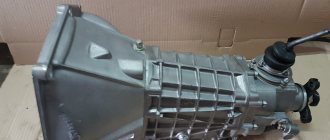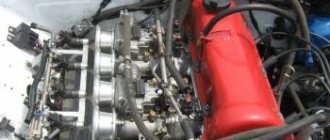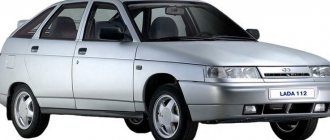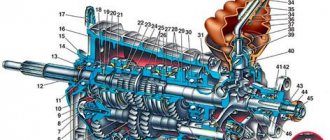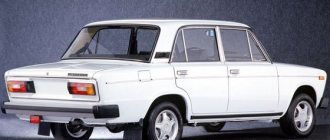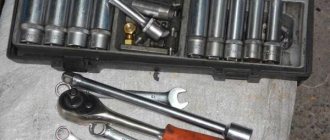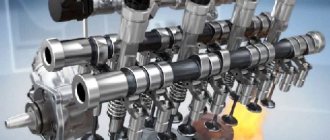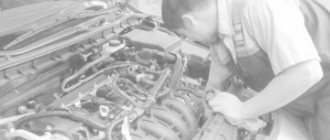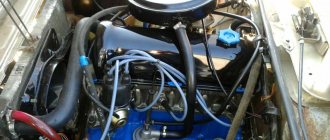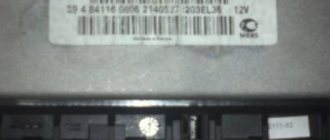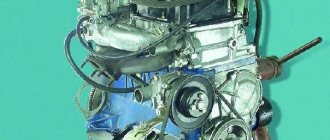During the day with a lantern
The rear lights of the “six” looked like a curiosity for our automobile industry. They combined turn signals, parking lights, brake lights, reversing lights and reflectors in a single housing.
The lights on the “six” illuminated the license plate—it looked like no one had ever done this before.
The lights on the “six” illuminated the license plate—it looked like no one had ever done this before.
What is good about the Zhiguli suspension?
On all models of the VAZ classic, the suspension configuration is the same: in front there is an independent multi-link with an anti-roll bar, in the rear there is a dependent beam.
The six is soft to drive and feels a little clunky. When passing uneven surfaces, it noticeably falls into the hole. The softness and design of the rear suspension affects cornering performance. Also, the light rear of the car bounces great on bumps, which makes it really scary when driving over 100 km/h.
The main advantage of the chassis is its high ground clearance (17 cm). You can safely move on bumpy roads and not be afraid of damaging the underbody or the engine.
The disadvantage of the suspension is the ball joints of the arms and steering rods. Due to the design features of the chassis and the quality of domestic roads, parts become loose, the boots on the balls break and control deteriorates. For major repairs you will pay about 5 thousand rubles.
It is better to make an inspection and replace all consumables immediately upon purchase. This will protect you from additional cash injections in the future and increase confidence in driving.
Also read: Not everything is so bad: pros and cons of LADA Largus
The last of...
Model 2106 was the last Soviet passenger car with a four-headlight system, with wheel caps and vents in the front doors.
In the multi-part series “TASS is authorized to declare” (1984), no less than KGB General Konstantinov, played by Vyacheslav Tikhonov, rides on 2106. During the course of the play, he needed to get to know the heroine Irina Alferova in a decent way - the “six” was suitable for this.
In the multi-part series “TASS is authorized to declare” (1984), no less than KGB General Konstantinov, played by Vyacheslav Tikhonov, rides on 2106. During the course of the play, he needed to get to know the heroine Irina Alferova in a decent way - the “six” was suitable for this.
And in the later film “Genius” (1991), the petty swindler Kostya, played by Sergei Prokhanov, rides the “six”. The “Six” by vocation drives a VAZ “Six” - after the collapse of the country it looked quite normal...
And in the later film “Genius” (1991), the petty swindler Kostya, played by Sergei Prokhanov, rides the “six”. The “Six” by vocation drives a VAZ “Six” - after the collapse of the country it looked quite normal...
The Magnificent Six: why the VAZ-2106 was the best Zhiguli model
A little history
The next Zhiguli model with the “working” index VAZ-21031 (similar to the VAZ-21011) was supposed to become a modernized “three-ruble note”, which we remembered quite recently .
If the VAZ-2103 was positioned as a luxury version of the regular Zhiguli, then the “six” was supposed to become an even more comfortable and dynamic version of the “troika” itself. So to speak, complete luxury. 13
2 / 3
3 / 3
At the same time, the designers still did not have carte blanche for a serious modernization of the body - as in the case of the “three-ruble note”, they were only allowed to slightly modify the front and rear parts. At the same time, the new car had to get rid of the “patina of the sixties” - more angular lines and significant use of plastic parts in decoration were rapidly coming into fashion. In addition, the designers had to solve the opposite problem in this way - a more “luxurious” model had to be made cheaper at cost than the previous one, abandoning complex and expensive parts to produce, such as the radiator grille framing the optics and bumpers with L-shaped ends.
1 / 2
2 / 2
The VAZ designers coped with their task “excellently,” which we will talk about a little later and in more detail. In the meantime, a little chronology. The first “six” was assembled at the end of 1975, and mass production of the VAZ-2106 began in February 1976. In December of the same year, the “six” became the three millionth car produced in Tolyatti, and in June 1978 – the four millionth. A year later, the “six” was also noted as the millionth Soviet car delivered to the countries of the Union for Mutual Economic Assistance (CMEA).
Modification for the German market from the importer Deutsche Lada
1 / 2
2 / 2
Like previous models, the “six” was also produced with right-hand drive
1 / 2
2 / 2
At the Volzhsky Automobile Plant, the sixth model was produced until 2001 - that is, exactly a quarter of a century. And in 1998, famous for its default, the “geography of distribution of the six” became more extensive, because its production was partially transferred to other enterprises - first to Syzran, and then to the IzhAvto enterprise in Izhevsk, where it was produced until the end of 2005. Thus, the “six” was produced at different car factories for a total of exactly thirty years - one of the longest assembly line lifespans for a specific model. Of course, the production process was not without upgrades and updates, which did not always benefit the car itself. And yet, how did the “six” manage to earn such love and respect from Soviet and Russian motorists? After all, cars with characteristic plastic “glasses” around four round headlights have produced no less than four million copies over three decades - again, almost a record figure for one specific model.
1 / 3
2 / 3
3 / 3
Technique
VAZ designers V. Antipin and V. Pashko were able to really modernize the “three-ruble note” using minimal means, making its appearance stricter, more laconic and at the same time “fashionable”.
Plastic “fangs” and ends of the bumpers, headlight frames, taillights that were completely original in design, other caps – it would seem like small touches, but the “six” was really perceived by contemporaries as a new model, and not a modification of the usual “troika”.
The Six looked even more prestigious than the VAZ-2103
At the same time, the designers and artists faced a very difficult task: they had to improve the Italian design without spoiling it. By that time, VAZ had already acquired sufficient experience and had a certain taste, which made it possible to make the “six” even better.
BEFORE LATER DEVELOPMENTS OF THE FIFTH FAMILY, THE VAZ-2106 STILL HAD ONE UNDOUBTED “EXTERIOR” ADVANTAGE – ITS APPEARANCE WAS MUCH MORE COMPLETE.
Indeed, on the “zero fifth” and “zero seventh” models, the angular bottom was by no means ideally combined with a smooth roof and a small slope of the pillars and windows (especially the side ones).
1 / 6
2 / 6
3 / 6
4 / 6
5 / 6
6 / 6
There were also plenty of changes in the interior. In the interior of the “six”, the attention was attracted by the completely velor upholstery of the seats; in addition, headrests appeared on the front ones, and in the instrument cluster there was a separate indicator for insufficient brake fluid level and a rheostat that smoothly changed the brightness of the backlight.
1 / 4
2 / 4
3 / 4
4 / 4
Even such an insignificant “trifle” by today’s standards as an alarm system first appeared on the “six”. Another new feature is a steering wheel-mounted windshield washer control instead of the foot-operated switch found on earlier models.
ANOTHER IMPORTANT ADVANTAGE OF THE VAZ-2106 OVER OTHER ZHIGULI MODELS WAS HIDDEN UNDER THE HOOD.
As in the case of the 1.3-liter version 21011, the designers increased the cylinder diameter from 76 to 79 mm, which, in combination with the “triple” piston stroke, led to an increase in the displacement to 1.57 liters.
1 / 4
2 / 4
3 / 4
4 / 4
Thanks to its long stroke, the engine increased torque by 12% compared to the 2103 engine, becoming noticeably more torquey at low speeds. At the same time, the designers made the transmission of the “six” much more “fast”, reducing the gear ratios of some gears and the main pair. As a result, with a calculated engine power of 80 hp. The Lada sixth model crossed the speed limit of one and a half hundred, accelerating to 154 km/h.
1 / 2
2 / 2
The 2106 engine was objectively the pinnacle of the Soviet small car industry, because later “classic” models used engines of smaller displacement and power, and front-wheel drive “one and a half” produced only 70 “horses”.
1 / 2
2 / 2
Of course, over time, the “Seven” had a modification with an engine from the VAZ-2106, designated 21074, and in the Niva, already in the post-Soviet period, the displacement was increased to 1,700 “cubes”.
DURING THE USSR, THE “SIX” IN THE REAR-WHEEL LINE WAS REALLY THE MOST POWERFUL SOVIET CAR WITH A MAXIMUM DISPLACEMENT ENGINE.
To be fair, not the overwhelming majority were released. The most widespread modification was the 21061 with a one and a half liter 2103 engine, and in the late eighties, under the hood you could most often find the weakest engine possible, that is, the 1,300 cc unit 21011, which was installed in the body of the sixth model until 1994.
1 / 3
2 / 3
3 / 3
Comfort
The six was close in terms of noise insulation and smoothness to its “ancestor” of the third model. And after the “three-ruble” was discontinued in 1985, it turned out that the quietest, softest and smoothest was the “six”. In addition, the new models (2105 and 2105) were still inferior to the “six” in terms of the quality of interior finishing, because the operating experience of the “fives” and “sevens” showed that their interiors with molded plastic parts are much noisier than the latter.
The interior of the VAZ-2106 cannot be softer. In subsequent models, there was noticeably more hard plastic.
And after another 10-15 years, when the interiors of all Ladas became equally outdated, the interior of the sixth model began to look “classically noble”. Just look at just one instrument cluster, which consisted of five separate round instruments! And at the end of the nineties, the arrow “watches” were already perceived in a completely “Jaguar-like” way.
Alas, NOT EVERYTHING REACHED FROM THE LUXURY OF YEARS OLD TIMES TO THE END OF THIS MODEL'S CONVEYOR LIFE.
1 / 3
2 / 3
3 / 3
Gradually, the wood-effect film was replaced by plastic, velor gave way to much more prosaic textiles, instead of chrome on the outside and inside, black plastic began to be increasingly used, and the color scheme of the interior noticeably “grayed”, losing the bright colors of previous years.
On export “sixes” there was PTF under the rear bumper
On the other hand, in cars of later releases such important “little things” appeared, such as an electric heated rear window and a rear fog lamp.
VAZ-2106 DID NOT LOOK AGAINST A POOR RELATIVE AGAINST FRONT WHEEL WHEEL VEHICLES, BECAUSE IT WAS NOTICELY MORE SPACIOUS AND QUIET THAN THE “CHISEL”.
But not everyone needed the excellent stability and controllability characteristic of Sputniks. That is why Soviet motorists, especially the older generation, if possible, chose not the most modern VAZ equipment, giving preference to the time-tested and so comfortable “six”.
A “blanket” of sound insulation under the hood is an invariable feature of luxury Lada cars
Image
At the time of its appearance, the VAZ-2106 was the top of the Togliatti model range, both in terms of positioning by the manufacturer and in terms of equipment. It is not surprising that this immediately affected the price of the car - to become the owner of the “best Zhiguli”, at that time you had to pay 9,100 rubles. At the same time, the Niva, with all its complex transmission and impressive off-road potential, was even 100 rubles cheaper!
1 / 4
2 / 4
3 / 4
4 / 4
For almost ten years, the third and sixth models were produced in parallel, and later they were joined by the “five” and “seven”. Even despite the “Mercedes” front end and more modern design solutions, the new Zhiguli models never managed to dislodge the “six” from its imaginary pedestal, which until the early nineties was considered the most prestigious VAZ model.
1 / 2
2 / 2
Only the release of a four-door sedan on the Samara platform somewhat weakened the position of the 2106, but the final blow to the image was dealt by the “ten” - a car that, structurally, in a number of decisions, was more modern than the VAZ-2106 by not one, but two generations. A sixteen-valve engine, glued glass, a “slicked-back” body – against the backdrop of “ten” innovations, the “six” already looked like a clear alien from the past.
DEFINITELY, IN THE NINETEIES, THE VAZ-2106 LOST A COMBINED SHARE OF LUXURY AND GLOSS, CHARACTERISTIC TO CARS IN THE VERY FIRST YEARS OF PRODUCTION.
However, at the beginning of the 2000s, “grandmother was spruced up” - at new factories the VAZ-2106 was painted in metallic color, equipped with an injection engine and more comfortable front seats... Alas, the car completely lost those finishing elements that, in fact, distinguished this model from more “budget” VAZs. And at the beginning of the troubled nineties, which I don’t really want to remember now, the “six” was produced without chrome moldings on the body at all! True, a couple of years later at VAZ they finally came to their senses and returned the chrome to its place.
1 / 2
2 / 2
It’s funny, but at a certain time the same car had a completely different image in the eyes of potential buyers: if young motorists saw it only as an outdated and deteriorated “classic”, then representatives of the older generation looked at it as “that same magnificent six” - the most expensive, dynamic and well-finished car of the Volzhsky Automobile Plant.
The late “six” almost completely lost its chrome finish
To be fair, we note that for a considerable time the sixth VAZ model really was just that, offering the Soviet consumer maximum comfort and luxury - if, of course, this word applies to one of the most popular cars on the planet.
Release chronology
1975 - the first VAZ-2106 was released 1976 - mass production began 1998 - production was partially moved to (Syzran) 2001 - production began at the Anto-Rus plant (Kherson, Ukraine) 2002 - production of the model from Tolyatti was transferred to the IzhAvto plant (Izhevsk) 2005 – model production discontinued
Modifications
VAZ-21061 engine VAZ-2103 VAZ-21062 right-hand drive VAZ-2106 (1.6 l) VAZ-21063 engine VAZ-21011 VAZ-21064 right-hand drive VAZ-21061 (1.5 l) VAZ-21065 “improved” version with five-speed gearbox "and bumpers 2105 VAZ-21066 right-hand drive VAZ-21063 (1.3 l) VAZ-21067 engine with injection system VAZ-21067-20 VAZ-21068 engine 2108 (unit carrier during the development of Sputnik)
Some modernizations of the VAZ-2106 during production during the Soviet period
1977 - minor changes in the instrument cluster 1980 - Ozone carburetor instead of Weber 1982-1987 - partial abandonment of chrome exterior trim 1986 - rear brakes from model 2105 1987 - gearbox from model 2106 1987 - elimination of the reflector on the rear wing and signal lights in the front doors 1987 – exhaust ventilation grilles from 2107 1990 – plastic gutters instead of chrome 1991 – caps 2101 instead of 2106
Survey
Your attitude towards the VAZ-2106:
Your voice
Total votes:
"Six" - tourist
One of the VAZ team’s ideas for a new touring car involved a two-seater pickup truck with a tent in the back. They made a car based on the 2106, but in the end the authorities did not approve of the creation, and the “Tourist” remained in a single copy.
Such machines, as usual, existed in single copies, and therefore always attracted the attention of the public. And even today they are attracted.
Such machines, as usual, existed in single copies, and therefore always attracted the attention of the public. And even today they are attracted.
Content
- What are the problems with VAZ-2106 engines and gearboxes?
- What is good about the Zhiguli suspension?
- Can the interior of the “six” surprise?
- What disadvantages will you have to put up with?
- How much does a VAZ-2106 cost and with what problems is it sold?
- Is it worth buying a Zhiguli and for whom?
"VAZ-2106" is the most durable and popular car of the Soviet automobile industry. In megacities it is not found so often, but outside the cities it always finds its admirer. Over the past three months, through the avtocod.ru service, it has been searched 46.5 thousand times, placing it in ninth place among other cars. What old Zhiguli cars are sold with today and who they are suitable for, we tell you in the VAZ-2106 review.
Soviet cars
Years of production: 1976-2006 Dimensions (l x w x h, mm): 4116x1611x1446 Layout: front engine Drive wheels: rear Body: sedan Engine: VAZ-2106 Number of cylinders: 4 Displacement: 1.57 l Number of valves: 8 Location : top Power, hp/kW: 80/58.8 at 5400 rpm Transmission: five-speed manual Brakes front: disc Brakes rear: drum Electrical equipment: 12 V Tire size: 175/70R13
History of creation
VAZ 2106
- Soviet passenger car developed at the VAZ plant. Serially produced from 1976 to 2006. The Six is based on the Italian model FIAT 124 Speciale from 1972. VAZ 2106 has become one of the most popular VAZ models throughout its production history. The first car of the new model rolled off the assembly line on February 21, 1976. In fact, the VAZ 2106 was a luxury version of the VAZ 2103, with a more powerful engine and different trim. The car was one of the most prestigious models of the late 1970s. The standard equipment was extremely rich: it included new seats with headrests and an instrument panel with a tachometer and clock. The cars were famous for their excellent dynamics and good build quality. Early models were distinguished by good sound insulation.
Motor
Increasing engine power is not a difficult task. You can change original spare parts and improve engine performance.
- They install collectors.
- The turbine and corresponding pistons are modified.
- Increase speed thanks to the installation of lightweight valves.
- Mount the crankcase.
- They can change a carburetor engine to an injection one.
- Suspension.
- They install sports brake discs and also install a large cylinder.
- Change the shock absorbers to stiffer or sportier ones.
- Hinges are modified. The original hinges are replaced with tuned ones.
- To improve maneuverability, the diameters are changed.
- Transmission.
The factory box can be changed to a sports box. Thanks to this change, gear shift speed can be increased.
Car modifications
The VAZ 21061 model, which was equipped with an engine from 2103, was one of the popular ones. A simplified motor cooling scheme - there was no electric fan, instead there was an impeller on the pump. When the engine was running, the radiator was constantly blown with air flow. In the 90s, bumpers from the VAZ 2105 model were installed. Cars for export had slightly improved finishes and bumpers from the Niva. VAZ 21062, 21064 are a “six” with right-hand drive. VAZ 21063 was equipped with a 21011 engine. Differences from 21061:
- presence of an electric fan;
- oil pressure indicator;
- exhaust system with one resonator.
Like 21061, this model could come from the factory equipped with VAZ 2105 bumpers. VAZ 21065 is a modernized “six” that was produced in the 90s. Innovations:
- powerful generator;
- 5-speed gearbox;
- rear axle with gearbox, which has a gear ratio of 3.9;
- contactless ignition;
- Solex carburetor;
- headlights with halogen lamps;
VAZ 21066, which was exported, had a right-hand steering wheel, a 1.9-liter engine, power steering, ABS, a leather interior, 17-inch wheels, an automatic transmission, and full power accessories. And for the domestic consumer, the classic was produced under the modification VAZ 21067, equipped only with an injection system, and VAZ 21068, which used G8 components.
See you in ten years
Side view Pavel Kim Personal car Renault Duster. A fan of cars for an active lifestyle.
In order for a car to become a historical value, a combination of factors is necessary, such as the impressive age of the car, the smallest possible circulation of the model and the excellent condition of a particular instance. The green VAZ-2106 satisfies only one of these requirements - the car, produced in 1982, has just been restored and is in perfect condition. But the fact is that from 1975 to 2005 more than four million “sixes” were produced, many of which are still running on the roads, like a bucket of tar in a barrel of honey.
But there is one thing that makes me look at this car as a collector's item. The owner of the car was the legendary climber Valery Khrishchaty, and it still belongs to his family. The car was purchased in 1982, when Khrishchaty received the right to buy a car without waiting in line for climbing Everest at night. Compare with those Kruzaks and apartments that are given to Olympic medalists today, but the first ascent of the western face of Everest is better than other Olympic gold. To understand: Khrishchaty in mountaineering is like Gilles Villeneuve in motorsport. An incredibly strong athlete who stood up for the purity of the sport and left us at the peak of his career.
This fact makes the regular “six” something special for me: this is no longer the car that bombers use to taxi or workers carry construction materials with. All the difficulties, problems and shortcomings seem, if not features of the machine, then at least something that creates intrigue.
And yet the car fits surprisingly easily into traffic today. If you don’t yawn and change gears in time, the engine makes it easy to stay in the left lane; braking behavior is annoying, but the dynamics are quite acceptable, and the suspension performance will give a head start to many modern cars. In addition, many drivers realize that in front of them is an enthusiast driving a lovingly restored rarity, and they kindly let them pass. I left for the city in the evening, when the heat had subsided and the traffic was quite moderate, but an hour behind the wheel here is worth two in any modern car. True, surrounded by the same “sixes”, only younger and in worse condition, the feeling of touching automotive history disappears...
In 10–15 years, this car will shine, and when it reaches fifty dollars, it may well become, if not a collector’s rarity, then quite a museum piece. When the VAZ classics roaming the roads finally fall apart, we will look at these cars with trepidation. Guys, keep the VAZ-2106 in the garage, roll it out regularly and don’t forget to send the address if you move. I hope that in 10 years I will come to visit, find you and show the children what their parents were driven in when they were children.

